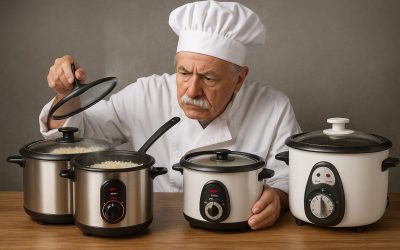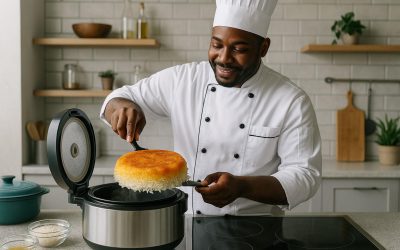As an Amazon Associate I earn from qualifying purchases.
Quinoa, often hailed as a ‘superfood’, has taken culinary realms by storm. Celebrated for its high protein content, dietary fiber, and a host of essential vitamins and minerals, it’s not only nutritionally rich but also incredibly versatile. As a pseudo-cereal, quinoa presents unique cooking considerations, especially when it comes to keeping it warm post-cooking.
Enter the Zojirushi rice cooker, a household name known for its precision and consistency in cooking grains. But how does it fare with quinoa, especially when we want our preparation to remain warm and ready-to-serve for extended periods? This article delves into the art and science of using a Zojirushi to keep quinoa at its flavorful best. Whether you’re planning a dinner party or simply want to enjoy warm quinoa throughout the day, we’ll explore expert insights, practical tips, and the optimal methods to ensure your quinoa remains deliciously warm without compromising its nutritious edge.
How Long Can I Keep Quinoa Warm in Zojirushi
The Zojirushi rice cooker, renowned for its “keep warm” feature, ensures that rice and other grains remain at an optimal temperature after cooking. When it comes to quinoa, the principles are similar to those of rice.
Typically, you can keep quinoa warm in a Zojirushi rice cooker for several hours without a noticeable decline in quality. Most Zojirushi models have a “keep warm” function that maintains food at safe and palatable temperatures, usually between 150°F (65°C) and 160°F (70°C).
However, there are a few considerations to keep in mind:
- Texture and Quality: While quinoa can be kept warm for hours, its texture might change slightly the longer it stays in the “keep warm” mode. Over extended periods, quinoa might dry out a bit or become overly soft.
- Safety: From a food safety standpoint, perishable foods shouldn’t be in the temperature danger zone (40°F – 140°F or 4°C – 60°C) for more than 2 hours. But since the Zojirushi’s “keep warm” feature maintains temperatures above this zone, quinoa can safely be kept warm for several hours.
- Moisture: If you anticipate keeping quinoa warm for an extended period, consider adding a touch more water than usual to compensate for the moisture loss during the warming phase.
- Reheating: If you’ve turned off the cooker and let the quinoa sit, and later decide you want to reheat it, you can use the “reheat” function available in many Zojirushi models. This will bring the quinoa back to a suitable eating temperature.
- Taste: Over time, even when kept warm, quinoa may lose some of its flavors. If you’re serving it after an extended warming period, consider adding some fresh herbs or a drizzle of olive oil to rejuvenate its taste.
In conclusion, while you can keep quinoa warm in a Zojirushi rice cooker for several hours, for the best texture and flavor, it’s recommended to consume it within 1-2 hours after cooking. If keeping it warm for longer, periodically check its moisture level and consider the tips mentioned above.
TIPS
If you’re planning on using the “keep warm” function of your Zojirushi rice cooker for quinoa, here are some handy tips to ensure you achieve optimal results:
- Limit Duration: Ideally, try to consume the quinoa within 1-2 hours of cooking. While the Zojirushi can keep it warm for longer durations, the texture and flavor might be best during the first couple of hours.
- Add Extra Water: If you anticipate keeping the quinoa warm for a prolonged period, consider adding a tad more water during the initial cooking. This compensates for any moisture lost during the extended warming phase and prevents drying out.
- Stir Occasionally: Gently fluff and stir the quinoa every once in a while to ensure even warmth and to prevent the bottom layer from becoming overly soft or mushy.
- Use Extended Keep Warm: Some Zojirushi models have an “Extended Keep Warm” setting which maintains grains at a slightly lower temperature. This can be advantageous for prolonged periods as it reduces the risk of overcooking or drying out.
- Check for Dryness: If you find the quinoa becoming too dry, you can sprinkle a bit of water over it, stir, and then let it continue warming. This will reintroduce some moisture.
- Safety First: Although the “keep warm” function keeps quinoa out of the temperature danger zone, don’t keep quinoa or any food in this mode for excessively long durations (like overnight) as the quality will degrade and there may be food safety concerns.
- Rejuvenate Before Serving: If quinoa has been kept warm for a long time, freshen it up before serving. Drizzle a little olive oil, squeeze some lemon juice, or mix in fresh herbs to enhance flavor and moistness.
- Avoid Repeated Reheating: If you’ve turned off the “keep warm” function and allowed the quinoa to cool, avoid reheating and then warming again multiple times. This can degrade texture and might raise food safety issues.
Remember, while the Zojirushi rice cooker is a fantastic tool for maintaining warmth, the primary goal is to serve and enjoy quinoa at its best quality. Keep these tips in mind and relish the delicious, fluffy quinoa every time.
Frequently Asked Questions (FAQ’s)
Q: How long can I safely keep quinoa warm in my Zojirushi rice cooker?
A: Ideally, quinoa should be consumed within 1-2 hours of cooking for the best texture and flavor. However, the Zojirushi rice cooker’s “keep warm” function can maintain quinoa at a safe temperature for several hours.
Q: Will the quinoa become mushy if kept warm for too long?
A: There’s a possibility that quinoa may become overly soft or lose some of its fluffiness if kept warm for extended periods. It’s best to check and fluff the quinoa occasionally.
Q: Is there a risk of the quinoa drying out?
A: Yes, prolonged warming can lead to moisture loss. If you anticipate a longer warming period, add a touch more water during cooking or sprinkle some water over the quinoa during the warming phase.
Q: Can I use the “Extended Keep Warm” setting for quinoa?
A: Absolutely! The “Extended Keep Warm” setting maintains a slightly lower temperature, which can be beneficial for quinoa if you plan on keeping it warm for longer durations.
Q: How can I enhance the flavor of quinoa that’s been kept warm for a while?
A: Fresh herbs, a drizzle of olive oil, or a squeeze of lemon juice can help rejuvenate the flavor of quinoa that’s been on the “keep warm” mode for some time.
Q: Is it safe to keep quinoa warm overnight?
A: While the Zojirushi’s “keep warm” function maintains a safe temperature, it’s not recommended to keep quinoa or any food warm for overly extended periods like overnight due to potential quality degradation.
Q: Can I reheat quinoa in my Zojirushi if it has cooled down after cooking?
A: Yes, many Zojirushi models have a “reheat” function. However, for the best quality, try to avoid multiple cycles of reheating and warming.
Q: How does the Zojirushi’s “keep warm” function differ in maintaining quinoa’s texture compared to other grains?
A: Zojirushi is engineered to maintain consistent warmth, ideal for rice grains. Quinoa, being a pseudo-cereal, has a slightly different composition. While Zojirushi does a commendable job, quinoa’s saponins can lead to slight stickiness if kept warm for extended periods, unlike rice which may simply dry out or become mushy.
Q: What’s the optimal temperature for keeping quinoa warm without compromising its nutritional value?
A: The Zojirushi’s “keep warm” function typically maintains temperatures between 150°F (65°C) and 160°F (70°C). This range is ideal for keeping quinoa warm without significant nutrient loss, especially since quinoa’s nutrients, like B-vitamins and minerals, are relatively stable at these temperatures.
Q: Are there any specific Zojirushi models best suited for quinoa?
A: Most Zojirushi models handle quinoa well. However, models with “GABA brown rice” or “Umami” settings, designed to soak and cook grains longer, might be more adaptable to quinoa’s unique properties, ensuring even cooking and optimal warmth.
Q: Can the prolonged warming of quinoa in Zojirushi lead to any alteration in its protein structure or amino acid profile?
A: Quinoa is lauded for its complete protein profile. Prolonged warmth can denature proteins to some extent, but the essential amino acids remain intact. However, repeated heating and cooling cycles might affect the digestibility and availability of these proteins.
Q: How does the moisture level in quinoa change during the “keep warm” phase, and how does it compare to rice?
A: Quinoa tends to release its moisture more readily than rice during the warming phase. This can lead to a drier texture over time. Sprinkling water can counteract this, but it’s a delicate balance to maintain the desired fluffiness.
Q: Is there any potential nutrient loss in quinoa if kept warm for too long in a Zojirushi?
A: While most nutrients in quinoa remain stable during the “keep warm” phase, prolonged exposure to warmth can lead to a minimal reduction in certain heat-sensitive nutrients, such as some B-vitamins. However, the loss is marginal and not of significant concern for short durations.
Q: Are there any culinary techniques to enhance the flavor and texture of quinoa if planning to use the “keep warm” function for extended periods?
A: Toasting quinoa lightly in a skillet before cooking can enhance its nutty flavor and improve its texture during prolonged warming. Additionally, adding a bay leaf or cooking in broth can impart a richer flavor that lasts through the warming phase.
These answers aim to provide a deeper insight into the nuances of keeping quinoa warm in a Zojirushi, ensuring both optimal taste and nutritional value.
Conclusion
The versatility of quinoa, combined with the advanced technology of a Zojirushi rice cooker, allows for a culinary experience that’s both convenient and healthful. While quinoa’s unique properties may differ from traditional grains, with the right approach, we can achieve a harmonious balance between warmth, taste, and nutrition. As we’ve explored, the key lies in understanding the nuances of both quinoa and the Zojirushi device, ensuring that this pseudo-cereal remains fluffy, flavorful, and nutrient-rich even during prolonged warming periods.
Incorporating the practical tips and expert insights discussed, you can confidently serve warm quinoa dishes that don’t just satiate hunger but also delight the palate. Whether it’s a casual family meal or a special gathering, embrace the prowess of your Zojirushi rice cooker and let quinoa shine as the super grain it truly is.






